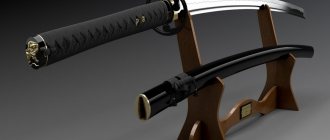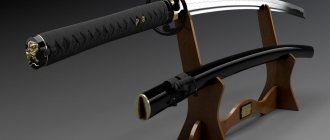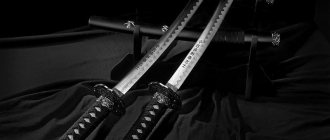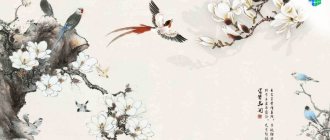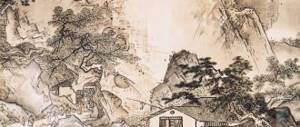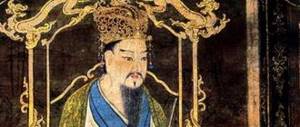A katana is a samurai sword with a curved blade, sharpened on one side, and a straight wooden handle. It was worn and stored in a magnolia sheath.
The size of the weapon is 95-105 cm, the blade is 60.6-75.7 cm, so it is classified as a cold weapon. The cutting part is made of several types of steel, it is both strong and sharp, and holds an edge for a long time. The katana was used in honor fights, held with both hands, but a grip with one hand is also possible.
The cost of an ancient weapon now reaches several thousand dollars; replicas from Japan can be bought for 2.5-60 thousand rubles.
Main characteristics of the katana
The katana has the characteristics indicated in the table.
| Options | Their meanings and features |
| total length | 95-105 cm |
| Blade length | 60.6-75.7 cm |
| Blade width | Up to 3 cm |
| Butt thickness | Up to 0.5 cm |
| Blade sharpening | One-sided |
| Sharpening angle | Up to 40-45 degrees in the middle part, up to 39 degrees at the tip |
| Handle | Straight, wooden, covered with shark skin, wrapped with silk cord |
| Handle length | 3.5 fists of the owner, that is, 25-30 cm |
| Blade steel | Combination of high carbon hardness 60-62 HCR with medium and low hardness material |
| Garda | Available, diameter – 7.5-8 cm |
| Presence of a scabbard | Necessarily |
| Is it a bladed weapon? | In most cases it is, but there are exceptions |
What is a katana
Katana is a Japanese edged weapon that belongs to the category of swords, although it is similar to a saber or checker. It has been known since the 15th century, it was owned by samurai. The weapon has a long, slightly curved blade, consisting of several layers of steel of different hardness, and a short handle in comparison with it. The katana was intended for delivering cutting blows, but with skillful use it could also stab the enemy.
Weapon length
The length of the katana together with the handle, that is, the full length, is 95-105 cm. The blade should be 60.6-75.7 cm, but on average this figure is 70-75 cm. That is, weapons of this type with shorter blades are much more common less often. This difference in the size of traditional weapons is due to the fact that they were personal and were made in accordance with the dimensions of the owner.
We recommend reading the article about the coolest knives known throughout the world. From it you will learn about the sharpest, most dangerous and beautiful knives, the ranking of the best knives in the world, the highest quality and most popular in Russia. And here you can read more about the benefits of the Nepalese kukri knife.
Dimensions
In addition to the length of the blade and the overall length, the following dimensions of the katana are important:
- the width of the working part is approximately 3 cm;
- butt thickness – from 0.5 cm.
These are the dimensions of the katana in centimeters, but in Japan the length of the sword was determined in its own units of measurement, and it had to be from 2 shaku.
There were no clearer criteria in manufacturing, especially when it came to the length of the handle. It was determined by the size of the weapon owner’s hand and was supposed to be 3.5 times his fist.
Katana weight
The weight of a katana varies from 1 kg to 1.9 kg. It depends, of course, on its size, but also on the forging method, the features and the number of different types of steel used. The nuances of the decor of the handle are also important. It should have cast decorations that increase the weight of the weapon. But it cannot fall out of the standard boundaries, otherwise it will be impossible to use the katana in the proper way.
What does it look like
The katana looks like a powerful sword with a slightly curved long blade and a straight hilt. The latter is separated from the chopping part by a hand guard - a guard.
The blade of the weapon is slightly beveled and rises up at the tip. In addition, the handle is decorated with decorative metal elements, covered with stingray or shark skin, and a silk ribbon is fixed over it in several turns. All this helps to hold a heavy weapon more securely in your hand.
Structure
The structure of a katana according to the regulations looks like this:
- Ha – cutting edge of the blade;
- Nakago – base of the cutting edge;
- Mekugi – Nakago bamboo fastener in the handle;
- Habaki - a fixing device for a blade so that it does not move;
- Tsuka – handle;
- Kasira – the head part of the handle;
- Monouchi - the surface of a weapon that strikes when struck;
- Mune - the unsharpened end of the blade;
- Shinogi - edge of the blade;
- Tsuba - guard.
- Saya – scabbard;
- Koi guchi is the place of entry into the sheath;
- Sageo – rope.
These are the main parts of the katana. The sheath is also an integral part of the samurai weapon, since it was worn on the belt not naked, but hidden in it. Sai allowed not only to keep the sword sharp and not rusty, but also to disguise it after the ban on wearing it was introduced.
The secondary components of the katana are:
- Ada – patterns formed during rolling;
- Hamon – hardening boundary;
- Dzi-ada – blade;
- Ha mati - the edge of the cutting edge of the blade;
- Kissaki - blade tip;
- Ko-sinogi – edge at the edge;
- Boti - the hardening boundary at the edge of the blade;
- Yokote is the dividing line of the tip;
- Mune mati - the edge of the blunt tip of the blade (Mune);
- Shinogi-ji - flat surface of the blade;
- Nakago-jiri – the final section of the cutting edge (Nakago);
- Mei – inscriptions on the base of the cutting edge (Nakago);
- Yasuri-me - notches on Nakago;
- Nagaza – the size of the blade;
- Sori - blade deflection;
- Yaki-ha – hardened portion of the blade;
- Menuki - ornament on the handle;
- Same-hada – fish skin, covering the handle;
- Kurikata – rope loop (Sageo);
- Shitotome - a hole through which a loop for a rope (Kurikata) is threaded;
- Footi – handle coupling;
- Sepa - washers;
- Tsuka-ito - silk cord wrapped around the handle;
- Kojiri is the end point of the sheath.
Blade
The katana blade has a one-sided sharpening, its line has a smooth bend. It should be finished to a razor-like finish, tapering to a point or be uniform along its entire length.
In the first case, the masters achieved the following indicators:
- the middle part (from 2 cm from the guard to the middle of the blade) was sharpened to 40-45 degrees;
- the upper part (from the middle to the tip) was processed to 39 degrees.
And the maximum thickness of the blade spine is 5 mm. This combination of sizes of blunt and sharpened edges gives the sword special fighting qualities.
The required thickness of the katana blade was achieved, among other things, by polishing at the final stage of manufacturing. First, it was sharpened with rough stones of varying abrasiveness, then processed with more delicate material. The sharp edge of the blade should be smooth, without jagged edges.
Sword steel
Steel for a katana must have a high degree of carbon content, that is, be a hardness of at least 60-62 HRC. But the blade is always made multi-layered, that is, several varieties of it are used and different ways of combining them.
Mild steel or steel combined with medium steel gives the weapon elasticity, which means it does not break under heavy load. Hard provides the blade with high sharpness for a long time.
The methods of combining different types of steel differ. Sometimes the soft and middle layers are the central layers of the blade, and the hard lining is on the outside. In other cases, the high carbon steel is on the inside and the outer layers are made of lower carbon content material.
Blade designs according to the types of steel used are of the following types:
- maru, in which there is only one type of material - high-carbon;
- kobuse, where the rod is made of soft steel and the lining of harder steel;
- khonsammai, in which the inner layer is soft, but the tip is high-carbon, and there are outer linings of a medium-hard material;
- Shihozume, similar to the previous design, but with the back of the blade protected by a strip of medium-hard steel;
- makuri, where the core is soft and the shell is completely hard;
- warha tetsu, in which the tip is made of high-carbon material and the lining is made of soft material;
- orikaeshi sammai, which is an improved form of honsammai;
- gomai, where the thin inner rod is made of hard steel, it is covered with a layer of soft material and again hard material on the outside;
- sosu kitae, which combines seven layers of different types of steel, which gives the highest possible quality.
Katana is a saber
A katana is a saber by European and Russian standards. It is classified as this type of weapon because of its curved blade and its one-sided sharpening.
But the Japanese are sure that the katana belongs to the category of swords for the following reasons:
- it is used primarily for cutting and piercing blows, and for chopping with a saber;
- the handle continues the line of the blade, and does not bend;
- the weight corresponds to the same indicator of other swords, and the second type of weapon is much lighter;
- You can operate a katana by taking it in your left, right hand, or holding it with both, which will not work with a saber.
Watch the video of an expert's opinion about the Japanese Katana sword:
Is it a bladed weapon?
A katana is a melee weapon if its parameters fall within the formal characteristics of weaponry reflected in GOST R 51215-98. There are definitions of sword, blade, blade, point, consistent with what can be seen in most antique products of this type. If an ancient katana or replica has discrepancies with the requirements of the standard, they cannot be called a bladed weapon.
A product may exclude, for example, one of the following characteristics from the chemical weapons category:
- movable connection of the blade with the handle;
- an unsharpened blade that cannot cause cutting damage;
- blunt edge, with no chance of causing a puncture wound.
If they are not there, the katana can be a historical property, a collectible, an antique, and in all cases it is required to have permission.
Longest katana
The longest katana is called "okatana". Belonging to this subtype of weapon is determined by the size of the blade; it must be larger than 2.5 shaku, that is, from 75.8 cm. The largest full size of a long sword is 105-130 cm. The shape of the blade and handle in all cases is the same as that of a traditional weapons of this type.
Katana
LiveInternetLiveInternet
Two words about the steel itself. In my opinion, the statement that katana blades had such unique properties mainly due to the fact that they were made from raw materials mined from sands and containing large amounts of molybdenum and tungsten is somewhat untrue. For the simple reason that their content in this steel is too small to have an alloying effect, and besides, the temperature obtained in the furnaces of that time was clearly insufficient to melt tungsten. This is also supported by the fact that Japanese craftsmen were happy to buy “raw steel” brought from Europe. But let's move on. The master buried the blank of the future sword in the ground near volcanoes or geysers for several years, as a result of which the “weak metal” was eaten away by rust, and the remaining metal was used to make the blade. The next feature of the katana blade is hardening. In all the photos, a certain wavy line is clearly visible and even emphasized at some distance from the cutting edge along the entire length of the blade. Experts distinguish up to 20 types of this line, from slightly wavy to very intricately curved, but one way or another, all these are nuances, and the point is that only the cutting edge was tempered, and not the entire sword. It is interesting, of course, to figure out why, having mastered the technology of “Damascus steel,” Japanese gunsmiths did not follow this path. The answer, I think, lies in the following. Damascus steel, as well as damask steel, do not tolerate frost well. There is such a quality of steel - cold brittleness; while studying at the institute, I did laboratory work on this topic. Accordingly, for the sake of the experiment, about a dozen special blanks were broken on a special stand, which were previously cooled to the required temperature in dry ice. And yet, yes, the graph clearly showed that the strength of steel drops abruptly with decreasing temperature. The metal becomes brittle.
For structural (rather common, widely used steel grades) this unpleasant phenomenon begins at approximately minus 25 - 30 degrees Celsius. I personally have not had the opportunity to test damask and Damascus steel in this way; I judge only from publications. I’m not sure that in Japan there are such frosts in winter, but I haven’t come across any detailed research on the cold brittleness of Damascus steel, maybe this threshold for Damascus steel, due to the technology by which it is manufactured and the presence of internal stresses, begins much earlier than minus 25 degrees .
The process of creating a katana.
The blade of the sword is like the flow of a mountain stream. I admire it on a clear summer morning.
Have you ever touched a samurai sword and felt not cold steel at your fingertips, but a hot, living flow of energy? It’s as if this blade contains the soul of the master who made it, and the emotions of the warriors who pulled it out of its sheath to defend the honor of the samurai. The katana appeared in the everyday life of Japanese warriors around the 12th-13th centuries, and over the centuries since then its design has hardly changed. The sword fell into the hands of the samurai already spiritualized; it takes years to make it. Each generation of craftsmen introduced their own nuances into the manufacture of katana. Today there are swords from 4 eras:
- Kato (made up to the 16th century inclusive);
- Shinto (XVII century);
- Shinshinto (late 18th-early 19th century);
- modern Gendaito.
Swords differ both in the texture and color of the blade, as well as in properties. Katanas from the Kato era have dark gray blades; the best examples have the metal polished to a velvety matte finish. The steel of Shinto and Shinshinto swords is lighter and brighter. The reason for this difference is not that the traditions of the Kato masters were lost, but that different raw materials were used to produce swords of later eras, affecting the fighting qualities of the weapon. For example, modern katanas and Shinshinto swords can be easily
they cut through bundles of bamboo, while Shinto's blades crumble and Kato's are crushed.
Name of the parts of the katana. Metal production The metal from which the ancient katana is made has a unique layered structure. There are several technologies for producing high-quality weapon steel for katanas. The first method of making steel
Iron ore, rich in tungsten and molybdenum impurities, was mined from satetsu sand. The resulting raw materials were burned, cut into crumbs and burned again. This process saturated the iron with carbon, turning it into raw steel - oroshigane. To separate high-quality steel from metal weakened by the presence of slag, oroshigane was unforged, cooled in water and crushed, easily breaking out the slag pieces. The quality of water was of great importance, so most forges were located near mountain rivers and springs. Because the raw steel was not homogeneous enough, it was forged and welded several times until a high-quality pure steel was obtained.
The second method of making steel
Another method of producing steel appeared in Manchuria and began to be actively used by Japanese craftsmen at the end of the 14th century.
It involved long-term smelting of iron ore in Tatar furnaces. The process was labor-intensive, expensive, but effective: to obtain 5 tons of smelted metal, called kera, it took several days and dozens of tons of coal. Almost half of the kernel is steel with a 1.5 percent carbon content. The remaining part was a conglomerate of several metals, including dzuku cast iron. Before becoming weapon steel, the metal had to pass one more test - the test of time. The workpiece was buried in damp soil near volcanoes and geysers, and over several years the rust ate away the “weak” parts of the metal. Metal processing: reduction of carbon content From the carbon-enriched steel obtained by one of the indicated methods, a blank was made for the future blade. At the same time, it was necessary to reduce the saturation of steel with carbon, since its content of more than 0.8% makes the metal hard, but brittle after hardening. Carbon was burned directly from the blade blank in stages. Raw steel was forged into a plate, cooled in water and split. The resulting pieces were sorted and laid out on a blade made of iron or raw steel, fixed with clay and forged at high temperature. The resulting block was folded in half, cut across, welded, then folded in half again, this time cut lengthwise, and welded again. Several such cycles were carried out, up to 15. With each such doubling, the carbon content decreased: after the first stage by 0.3%, after each subsequent one - by 0.03%. Thus, it was possible to quite accurately detect the moment when the level of hydrogen in the steel dropped to the required 0.8%. Each master decided for himself what the final composition of the steel would be: some preferred to work with a strong, but softer metal, while others were interested in hardness, even if the blade became very fragile. Each doubling stage added new layers to the workpiece. From a mathematical point of view, there should be millions of them, but since the molecules of the thinnest plates were mixed during the welding process, in reality there were several thousand layers. Techniques of the Various Weaponry Schools Each of the more than 1,800 weapon schools had their own secrets for forging blades from the resulting high-quality steel.
But at the same time, each master followed the same rule for everyone: the blade of a long sword should be hard, and the remaining parts should be strong, but softer. Most craftsmen made three-layer blades according to the san-mai scheme: a hard but fragile, sharply sharpened blade is surrounded on both sides by softer, viscous iron linings. A slightly improved technology involved wrapping a steel blade with an iron “shirt” on three sides. In the famous Bizen province, recognized as the weapons center of Japan, a completely opposite technological method was used - kobu-shi. Craftsmen from Bizen used iron to make the base of the blade, which was “wrapped” in weapon steel. The blade of the blade was forged from the solid part of the steel “shirt”. In this case, it was necessary to know special hardening methods that would provide the blade with high elasticity without loss of hardness.
Types of Japanese blades.
Sharpening and grinding Having made a slightly curved 60-70 cm blade with a width of 3 cm from the resulting steel, the master began sharpening and grinding. The katana is sharpened on only one side so that the sword can be used in both mounted and foot battles. Shifting the center of gravity to the tip makes it easier to deliver slashing blows. The blade was also polished in stages, each time reducing the grain size of the grinding wheel (a total of 9-12 wheels were used). At the last stage, the master polished the steel with his fingertips using finely ground charcoal. The appearance of a mirror shine meant the birth of the katana. After polishing, a longitudinal line appeared on the blade - hamon, indicating the boundary between the matte surface of the steel blade and the mirror-shiny softer part, jigane. On the highest quality blades, jigane has a hada pattern similar to the surface of Damascus steel.
Katana blade
Sometimes jamon is called the tempering line, which is not entirely true, but has a basis. If the blade was hardened using the Kobushi technology, then the hamon was manifested through the use of clay. Before hardening, the part of the blade that was supposed to maintain viscosity was coated with clay, leaving the area of the blade free. The blade was heated and hardened in water. At the same time, the open part cooled faster, acquiring the desired hardness, and the part hidden under the clay became more elastic due to long cooling.
At the junction of these areas, jamon appeared. A blade hardened in this way was called yaki-ba, which means burnt. Experts call the samurai sword, the katana, the most advanced bladed weapon ever created by man. As an example of modern work on creating a katana, you can watch this video.
Source: Metal Processing
Bokken and bokuto.
Let’s just first agree on the terms; for some reason, a wooden katana for training in Russia is usually called “bokken”, although in the homeland of this sports equipment, a straight sword is called “ken”, and everything that is slightly curved has the ending “to”. Therefore, I think it would be more correct to call what is usually called “bokken” - “bokuto”, and, sorry for some disrespect, to call a straight stick “bokken”.
I myself became interested in this simple projectile, being carried away by finding out what the natural one was made of - iron, katana, and involuntarily studied the areas of knowledge adjacent to this issue. Purely theoretical for now.
So, “bokken”, from which you can make it yourself in Russia. In essence, a bokken is just a straight stick, rather a staff, which must be carefully selected and lightly processed in accordance with the traditions of this art accepted in Japan.
In Japan itself, during training they often use a bundle of split bamboo, sometimes tied simply with a rope across it, sometimes with more intricate devices - pieces of leather. This projectile is called a shinai. The handle is usually made of woven material and there is a guard, a ring to protect the hand from a blow sliding along the blade. It is believed that this is enough for “primary school”. But the precautions taken are not at all comical; the list of training armor required for training even with this bunch of bamboo is impressive!
Now about the “Bokken” itself. Considering that in the hands of a master this simple object becomes a formidable weapon, when transporting on an airplane it must be checked into luggage in a special sheath.
Given the relative simplicity of this weapon, you can make it yourself. It is only important to choose the right material.
In Japan itself, Bokken is made from white, red and black oak. According to Russian practitioners, the best material for bokken from trees growing in our country are boxwood, hornbeam and oak. There are mentions that bokkens impregnated with parquet varnish behave better, but this is optional. Any frills in design are not very welcome; as a rule, there is not even a guard. The most that a real katana and a bokken have in common is the weave on the handle. This is a special type of art; in Japan itself it is a separate type of craft passed down from generation to generation. Let me remind you that the handle of Japanese edged weapons, from the largest “tato” to the smallest “tinto,” is traditionally braided with a special silk braid. This braid is a consumable item, but can last a very long time. Each school's closely guarded secret is usually the final knot. The division into the handle and blade of the bokken is still rather conditional, indicated by a certain transverse stripe.
In all other respects, if there is no weaving on the handle, then the bokken, as a direct type of weapon, is no different from an ordinary staff. And the length is appropriate, there is something like a standard - 102 centimeters.
Experts recommend making a bokken from a branch, and not from a block cut from a trunk; knots can only be closer to the end, imitating a piercing-cutting end. In this case, the denser “northern” rings should be located on the “cutting” surface, this is if the bokken is slightly curved.
In cross section, the Bokken can be round, six-, octagonal, or flattened oval. To make it more similar to a real katana, a shallow groove is made along the bokken, which, when the bokken is positioned correctly, makes a characteristic rustling sound when struck. That's all it seems, a simple, but very formidable weapon.
Bulat and Damascus, what is the difference?
If you are a metallurgist by education, then this article will not tell you anything new, but if you are a humanitarian or financier, but at heart you are still a man and a warrior, then I think it will be interesting to you.
Damascus steel and Damascus steel, or rather edged weapons made from this steel, can rightfully be considered one of the pinnacles of technology invented by mankind. In many ways, this technology was the fruit of thousands and thousands of experiments, probably not without mysticism. But what is the difference between them? Let's try to figure it out. Being a technician by training, he knew very well what Damascus steel was, but confused it with damask steel, believing that it was just a matter of geography, but it turned out that this was far from the case! The difference between them is cardinal and to some extent Damascus steel can be called a fake of damask steel. I can’t say anything bad about Damascus steel, but this is still some approximation to the fantastic properties of damask steel, but still not quite the same.
First, a little history. Damascus steel, as the name implies, was historically learned to be made in what is now Syria, in Damascus.
Bulat's homeland is India. It was there, and practically only there, that they knew how to make damask steel, but the secret was so carefully guarded that, in the end, it was lost. The technology for producing damask steel is quite complex, so complex that even in our time it is impossible to reproduce it, although it would seem that we know everything about iron! But no, something similar - yes, it can be done, as an example of the attempt of the Russian engineer Anosov, who almost managed to reproduce damask steel, and he even left detailed instructions, but he either forgot to mention some small detail, or deliberately hid it, and even then What he was able to do cannot be reproduced in full.
Let's move on to the steel itself. Steel and cast iron are an alloy of iron and carbon and the properties of steel change depending on the carbon content. It's time to bring up the nightmare from the dreams of many generations of students - the iron-carbon diagram.
The most interesting for us are Cementite and Ledoburite. Alloys of iron with carbon in a very high concentration of the latter. But these are not all the properties of steel as a substance. Steel is not a homogeneous substance, like water, say, steel always consists of small crystals mixed together. And, lo and behold, these crystals can differ radically in carbon content! It was on this property that the secret technology for smelting Bulat steel was built. And this is precisely the fundamental difference between Damascus steel and Bulat steel. Bulat is boiled, Damascus is forged.
For now, let's take a break from Bulat and consider what Damascus steel is. Ideally, Damascus consists of steel rods welded together with different carbon contents. From this “braid” the blade is forged. Steel supplied from India was incredibly expensive and Syrian blacksmiths realized that approximately the same result could be achieved mechanically. Since a real blade is folded in half during forging up to a thousand times, layers of different steel turn into thin plates mixed together. In addition, during forging, the crystals are deformed, and internal stresses arise, giving even low-grade steel amazing properties, which, in fact, is what unscrupulous manufacturers take advantage of. It seems that in all external and qualitative characteristics the blade is very similar to Damascus steel, but still it is “third grade”, no more. Real Damascus is forged from at least two types of steel. The picture, so to speak, shows a “classic” blade made of Damascus steel.
Well, now we come to the main difference between Damascus and Bulat. At one time, steel for gunsmiths in Damascus was supplied from India and it was a considerable “export item” in the Indian economy of those times; Bulat was sold all over the world.
The unique properties of Bulat are due to the technology of smelting damask steel. Everything is the same, the same iron and the same carbon, but the output is a completely different product. Bulat takes hours, perhaps days, to cook. No matter how much I, even having a technical education, tried to understand what the point was, I still didn’t fully understand it. It is clear that when melting steel, convection currents arise and when such steel is cooled, crystals with one carbon concentration first solidify; when the temperature drops, on the other hand, steel crystals with different carbon concentrations are pulled into threads and intertwined with each other. Everything, it would seem, is simple! The result is a matrix of mild steel, saturated with “cementite” crystals, roughly speaking, steel mixed with cast iron. This can be roughly compared to a rubber sanding wheel in which diamond crystals are mixed. It bends in all directions but also cuts everything! Typical damask steel blade
The pattern of damask steel is distinguished by an uneven, chaotic pattern, while in damascus the waves and dots on the pattern are more harmonious, the pattern is more symmetrical.
Fig.4 On the left is damask steel, on the right is damask, both are “stainless”
And a few words about the samurai weapon - the katana. In essence, as can be judged from the examples that have come down to us from antiquity, the katana is a variation on Damascus, but not without elements of damask steel; we can say that it is a kind of synthesis of these two technologies, but it has one significant difference. Iron mined in Japan from placer sands is very rich in tungsten and molybdenum. It is the natural “alloying” of steel with molybdenum and tungsten that gives samurai blades their legendary properties.
The production of bladed weapons, however, like everything else in the East, was elevated to a cult and became a “high” art. Various parts of a samurai sword have their own names, which indicates the deepest development of production technology.
I think that not all the nuances are listed here, there are two more left. The first is that damask steel was smelted from “swamp ore.” I very much doubt that B.C. people already had tools and mechanisms for mining stone ore. And “swamp ore” includes the remains of plants that grew in those swamps, and this is not only carbon!
The second is heat treatment methods, that is, hardening, this is also a kind of art!
This is where it gets interesting!! — Types and designs of swords. Swords from different eras and countries
sources - www
https://arkanru.narod.ru/bulat_i_damassk/katana/bokuto_i_bokken/
https://www.topauthor.ru/
https://arkanru.narod.ru/bulat_i_damask/
History of the Samurai Sword
The samurai sword dates back to the end of the 14th century. The predecessor of the katana was the tati sword; in fact, thanks to its improvement, it appeared. The weapon was carried and used in combination with a short wakizashi. The latter is also classified as a sword.
The katana was an indispensable attribute of samurai weapons until the 20th century. True, it was previously banned from using it. But the Japanese began to hide weapons in simple wooden sheaths to create the impression that there was the same wooden sword there. Then tools with thinner blades appeared, similar to European cane swords. They forced the katana out of use, as they were more convenient to camouflage.
Watch the video for the history and review of the samurai sword Katana:
Scope of application
The katana was the personal weapon of the samurai, confirmation of his status. But also a weapon of defense, often used in duels. When determining its purpose, we can draw an analogy with the European sword or rapier. But, unlike Western weapons, the katana is not capable of damaging the armor of a samurai, especially if it was created before the 17th century. Those swords have a too fragile blade due to the high sharpness of the blade. But this did not stop them from being used in close combat with an enemy without armor.
Now the katana is not only a collectible weapon. Swords are used in fencing. There are several schools in Japan that teach the art of wielding this weapon.
The history of the appearance of the sword "Katana"
Katana and scabbard on a stand
Due to the late development of iron in Japan, weapons were imported from China and Korea for a long time. Only by the 7th century were blacksmiths able to master forging and processing multilayer steel. The first Japanese swords were straight and double-edged.
During the Heian period, in the 9th-12th centuries, in the context of horse fighting, weapons received a curved shape. Numerous internecine wars formed an entire class of samurai, for whom the sword became not only a weapon, but also a symbol. It was during this period that manufacturing technology was perfected.
During the Kamakura period from the 12th to the 14th centuries, armor improved, which required certain changes in bladed weapons. To increase the impact force, the weight increased and its shape changed. Such swords began to be used mainly in foot fights due to the complexity of fencing with one hand. This period is considered the heyday in the development of Japanese swords. Blacksmiths used unique technologies, many of which were subsequently lost.
During the Muromachi period from the 14th to the 16th centuries, various variations of Japanese swords appeared. Numerous wars required large quantities of edged weapons, and their quality has noticeably decreased. They were not allowed to purchase expensive weapons and constant ruin.
It was during this period that katanas developed. Their relevance arose against the backdrop of changes in fighting techniques, in which it was more important to get ahead of the opponent and strike the first blow. The appearance of slightly shorter swords marked the end of the Age of Old Swords.
The Momoyama period in the 16th century is characterized by the appearance of short swords. From this time on, wearing daisho (large-small) - katana and wakizashi - became relevant. The latter was more suitable for tight spaces.
This period marked the beginning of the Age of New Swords. Internecine wars subsided; peacetime no longer required large quantities of edged weapons. Japanese swords became part of the costume and a symbol of the owner's status. They were decorated with trim and decorative elements, often to the detriment of their fighting qualities.
In the second half of the 19th century, the Age of Modern Swords began. Weapons produced after 1868 are called gendai-to. Due to the ban on wearing it in 1876, many blacksmiths remained unclaimed, which led to a decline in production. At the beginning of the 20th century, in the context of a campaign to revive the country's cultural heritage, blacksmiths again received support.
How to hold and wear a katana sword
You can hold a katana either with one hand or with a two-handed grip, but the latter is more convenient. In this case, the blade of the sword goes to the target not at a right angle, but obliquely, to deliver a cutting blow. This technique was previously used in combat, and now it is used in fencing.
They wore a katana in a sheath, where the sword lay with the tip up. They were held behind the belt on the left side. Upon entering someone else's house, the samurai removed the weapon from its sheath and placed it nearby so that it could be reached.
The katana sword, held by the hilt with the left hand, indicated the samurai’s readiness to engage in battle. If it was on the right, it meant the owner had a peaceful attitude.
Combat characteristics of swords
The combat characteristics of Japanese swords are largely exaggerated. The exoticism of culture and military traditions have created many myths around the power of this weapon. In practice, after a series of examinations also carried out by Japanese experts, it was found that medieval European blacksmiths often achieved the same quality as Japanese ones.
The key feature of the Japanese sword is its fencing technique. The katana is used as both a two-handed and one-handed weapon. The main purpose is to deliver cutting blows, and in rare cases, piercing blows.
The blow is ensured by the movement of the sword along the plane of the longitudinal axis. The curved shape of the weapon allows for quick cuts. Given the weapon's sufficient weight, such blows could cut through traditional Japanese armor. However, the myths that katanas easily cut iron and other materials have no practical confirmation.
Types of katanas and their varieties
There are the following types of katanas:
- traditional;
- wooden, used as a souvenir;
- short - wakizashi;
- straight – kokatana;
- tactical – Tactical Katana Machete;
- with a red blade, where the steel contains gold.
There are also ancient and modern varieties of katanas. But the latter can be of no worse quality than those that have existed for several centuries, since the secrets of their manufacture are preserved and used by Japanese craftsmen.
Wooden katana
A wooden katana is a souvenir weapon used for historical reconstructions or in games. The sword is made entirely of solid beech, including the hilt. Other types of wood can also be used. The handle of the product is trimmed with genuine leather. This katana resembles an ancient samurai weapon only in shape.
Short katana
The short katana is a wakizashi sword. Both were worn as a pair on the left side of the belt, and were called a "daise" set.
Wakizashi has:
- length 50-70 cm,
- handle the size of 1.5 fists of the owner,
- blade 3 cm wide,
- butt 0.5 cm.
Wakizashi sword
But otherwise, it completely repeats the shape of a katana - a blade curved with a sharp edge and a straight handle. This weapon served as an auxiliary weapon in battle if the long sword broke or it was not possible to reach it.
The small katana was always with its owner if he found himself in someone else's house. And in this case the big one had to be removed from the belt and placed next to it.
Straight katana
The straight katana is called "kokatana". It could be included in a daiso instead of a wakizashi, that is, serve as a reserve weapon for a samurai. Kokatana has the following parameters:
- full length 60-69 cm,
- handle 15-17 cm,
- less curved, but not absolutely straight blade up to 3 cm wide.
Kokatana Sword (Ko-Katana)
And, unlike wakizashi, only aristocrats could wear a kokatana.
Tactical katana
The tactical katana has almost no relation to the ancient Japanese weapons, since it is a modern knife from Cold Steel called the Tactical Katana Machete. It is similar to a samurai sword only in shape - a curved blade, pointed at the convex edge, and a straight hilt.
Tactical Katana Machete parameters:
- total length – 92 cm,
- blade length – 61 cm,
- length of the sharpened blade segment – 57 cm,
- blade width – 3.3-4.5 cm,
- butt thickness – 2.2-2.4 cm,
- guard diameter – 7.7 cm,
- handle thickness – 2.1-2.8 cm.
Tactical Katana Machete
The metal part is made of carbon steel. The handle is made of polypropylene and features the finish pattern of a real katana. The set also includes a fabric case with plastic trim.
Dual katanas
Paired katanas are daisho, consisting of the katana itself and a shorter wakizashi. Another option for a samurai's weapon set is the first sword and straight kokatana, hung on the belt on the left side. But they never carried or fought with two katanas at once. The first is inconvenient, the second is unrealistic due to the size and weight of the weapon.
Paired Katanas
Katana with red blade
A katana with a red blade is one with a blade made of red steel, which contains gold and brass. This feature does not enhance the combat qualities of the weapon, but makes it very attractive in appearance and quite expensive. Usually the hilt and scabbard also have a red color to them.
Katana with red blade
Crossed katanas
Crossed katanas are nothing more than a symbol of readiness for battle. But in reality, it is impossible to see both weapons in the hands of the owner in exactly this position. Daise cannot be used at the same time. Crossed swords are marked only on graphic images, family coats of arms, and symbolize the military valor of the samurai family.
Reasons for popularity
The two-handed katana is in demand among collectors because this weapon is distinguished by its beauty and originality. Films in which valiant samurai wielded two swords at once (which is unlikely in reality), defeating everyone, contributed their share of popularization.
Another myth that adds interest is that weapons cannot be broken. This is due to information about the peculiarities of steel production and blade forging by the Japanese. Both processes are different from how it was done in Europe. And the very interest in Japan also contributes to the popularization of its ancient swords, even in the form of their modern replicas.
Why are so many ancient weapons preserved?
The Japanese were sensitive to weapons, passing them on to their descendants in each family. Samurai swords were of high quality and richly decorated, so they were the property of the family along with lands and monetary property. Accordingly, they were stored carefully; many weapons have survived to this day.
There are other reasons for the abundance of swords:
- there are more than 300 forges in the country that make weapons using ancient technologies;
- they are in great demand in Japan, thanks to interest in the art of swordplay and the schools where it is taught;
- The ancient guns are a cultural and historical treasure of the country, protected by scientific societies, so they were not allowed to be destroyed after Japan's defeat in World War II.
How much does a katana cost?
How much a katana costs depends on the age of the weapon, the manufacturing method, the finishing features of the handle and sheath, but a modern “remake” of good quality can cost 10-60 thousand rubles. A product of a worse level costs only 3-4 thousand rubles. A real katana from Japan will cost 300-500 thousand rubles, and sometimes even higher if it is a copy from a famous master with supporting documents. In 1995, one of these was sold for 600 thousand dollars.
Where to buy real one from Japan
You can buy a katana from Japan in gun stores. There are products made in this country at the present time, but in accordance with previous traditions. They can also be ordered online at international sites.
In Russia and other countries there are private collectors of weapons, who also sometimes part with some of their weapons. But you need to remember: if the sword has signs of chemical weapons, you will need permission to own it.
What factors influence the cost of a katana?
You can find a katana for sale in a specialized store or on the Internet. The price depends on some factors:
- quality;
- type;
- purpose;
- Manufacturer country;
- material;
- manufacturer's brand;
- pricing policy of the outlet.
Souvenir items are considered cheaper, while models made for battles are more expensive. When you mean real antiques, you will have to shell out a tidy sum. The supplier will charge additional fees for packaging and shipping. The product will cost much less if it is made in China. Accordingly, Japanese samples will be more expensive.
Making a Japanese katana sword
Traditional katana making is a labor-intensive and lengthy process that includes:
- cleaning steel from unnecessary impurities by immersing it in a solution of clay and ash;
- heating to high temperatures and folding with hammer flattening to obtain a multi-layer sheet of high-carbon material;
- forging, during which steels of different hardness are combined and the outline of the blade is formed;
- hardening of a workpiece coated with a layer of liquid clay so that martensite appears in some areas of the metal;
- release of material that already has the shape of a blade;
- sharpening and polishing, during which the modern Japanese katana sword acquires engraving on the working part;
- making steel guards and decorating them;
- making a handle, connecting it to the blade and guard using a bamboo fastening;
- making wooden scabbards.
Cheap modern samurai swords are made from simple stainless steel with a hardness of 56 HRC. And in this case, the process of creating them is not so complicated, it consists of cutting the blade, hardening, tempering, sharpening, making a handle and sheath, and assembling the product.
How a katana is made in Japan
Katana in Japan is made as follows:
- Pieces of special grade steel are placed in ash and clay solution to remove slag. Then they are removed and heated to join into a single whole, hammered, folded, and the previous step repeated until a sheet of high-carbon steel is obtained.
- A softer material is added to it to impart viscosity, which protects the blade from breakage. Forging takes several days, strips of steel of different hardnesses are combined in the way they will be arranged in the finished product. When the initial form is ready, a layer of liquid clay is applied to it.
- Next, in the process of hardening (heating the workpiece and cooling in warm water), a hamon is formed, that is, a pattern in the area between the blade and the transition to the butt. It will become final after polishing the blade, but first the latter is given a traditional shape - slightly curved.
- The next stage is product release. It is heated in an oven and cooled slowly in air. This is how the blade gains hardness without losing its viscosity.
- The finished metal part of the weapon is sharpened. To do this, use up to 9 special stones of different abrasiveness, and at the end - thin plates or wooden planks. At the same stage, some modern craftsmen apply engraving to the unhardened areas of the blade.
- All that remains is to polish the product. The master also works with different tools, thanks to which he highlights sections of the blade (hamon, hada, etc.). Along with sharpening, the process can last several days.
- Then a handle is made from magnolia or cherry, covered with stingray or shark skin, wrapped with silk, sometimes woolen ribbon. It is attached to the shank using a bamboo pin threaded through a hole on it. Between the handle and the working part of the blade there should be a guard (tsuba), attached using washers (sep). A coupling (futi) should separate the hand protection from the handle.
- The scabbard is made from wood. They are framed with decorations made of animal horn or bone and coated with varnish.
Watch the video about how samurai Katana swords are made:
Common defects of the samurai katana
A samurai katana is obtained as a result of a complex technological process, errors in which can lead to the appearance of defects that have certain names:
- Karasunokuchi – damage to the blade. If a crack penetrates the hardened and unhardened parts, the sword cannot be repaired; it is unusable.
- Sinae - transverse cracks in bend areas. They arise due to “fatigue” of the material and do not interfere with the use of the tool.
- Fukure are pieces of scale or coal preserved during the process of folding steel. The flaw spoils the appearance, as it is exposed after polishing. In addition, it reduces the strength of the sword.
- Kirikome - irregularities on the back of the gun. They form as a result of using a sword, but the problem is dealt with by polishing or not dealt with at all, since it is not considered serious.
- Umegane is a patch that hides another defect. It is placed by a blacksmith, wanting to correct mistakes in his work or make the visible inner layer of steel invisible.
- Hagire is a crack on the hardening line (jamon). If it was formed due to a notch, then it is not dangerous. And when the cause is too much bending of the blade, it is unsuitable for use.
- Hakobore is a large notch on the blade and hamon. May contribute to further deterioration of steel.
- Hajimi - dull areas on the blade that form during frequent sharpening. May mean the sword is old. But there is also evidence that it is made of poor steel, which quickly becomes dull.
- Nioi gire - the absence of a boundary between areas of hardened and unhardened steel where it should pass. It may mean that the hardening stage was carried out incorrectly, that is, the sword is unusable. But the same thing happens if the boundary between the mentioned areas is unclear, then this can be corrected by grinding.
- Mizukage is a dark spot on the cutting part of the blade. May form as a result of repeated quenching or cooling.
- Shintetsu is the penetration of the lower layers of steel to the surface. Occurs when polishing too hard or due to the age of the tool.
- Tsukare - thinning of weapons. The reason may be its age, that is, regular sharpening and polishing.
Defects of the katana
Katana sheath
The sheath of a katana, or saya, is made from magnolia to fit the blade. In cross section they can be oval, in the form of an ellipse or octagon with sharp or rounded edges. The saya is varnished, sometimes it is decorated with ornaments, like on the handle and guard, or covered with fish skin.
The entrance to the scabbard is decorated with horn and bone decor. But if you leave them without any decorations, it will not be a mistake. This is exactly what the saya became during the period when the wearing of a katana was banned by the emperor of the country. Currently, sheaths are also made of metal, but the inner layer must consist of wood.
What rules should you follow when choosing a katana?
- Studying the structure of the sword. Thanks to this, the difference between samurai swords of different quality will be clear.
- Required blade tip. Different martial arts require different blade sizes.
- Blade bend. This indicator is influenced by the shape. The model differs in the location of the deepest point of bend to the handle and blade, as well as in the radius of curvature.
- Design selection. This factor depends on the purpose of the purchase. If a sword is purchased as a souvenir, it is advisable to choose an original designed product. A training sword, first of all, should be comfortable and of high quality, and then aesthetically attractive.
Find a katana that fits on the Internet. However, it is advisable to buy such an item from a reliable company. It is very important that the samurai sword fits well, fits well in the hand, and is easy to use.
Which sword is longer than a katana
A sword longer than a katana is:
- Tati . It has a length of 75.7-90.9 cm, a more curved blade. And the handle of the weapon is not straight, unlike a katana. Tati is its predecessor and the basis for its creation.
- Nodachi . Its length is 1-1.5 m, and the longest sword of this type reached 2.5 m. It was created for battles with an enemy clad in armor. But to use nodachi, the samurai himself had to be physically very strong.
We recommend reading the article about the best switchblades. From it you will learn about the main characteristics of switchblades, their types and handmade switchblades. And here is more information about the Navaja combat knife.
It’s not for nothing that the katana is so popular among bladed weapon lovers. The sword is quite elegant, but durable, sharp, and affordable to own, as there are decent examples with a reasonable price. It will be a good addition to the collection, but will look no less impressive alone.
Our katanas
The swords made by our craftsmen are replicas of various Japanese designs.
They can rightfully be called “real” weapons, with the exception of combat sharpening. Our katanas do not belong to the category of “edged weapons”; they do not require special permission. The material used for the blades is hardened steel 65G, with a hardness of 50-52 HRC, which allows them to be used for contact fencing during training.
The tsuba (guard) is cast from a brass alloy or made of steel, depending on the model.
For the scabbard, beautiful wood species are used - oak, birch, and finished with textured or polished. The sheath is included in the price of the sword.
The handle is trimmed with leather and intertwined with cord for ease of use and to prevent slipping.
The blade is firmly embedded in the handle, making up approximately two-thirds of its length.
Individual changes to the blades are also possible:
- we make a separate blade;
- change the parameters of the blade – length, width;
- we apply an inscription or image to the blade by etching;
- We make custom blades (according to your sketch).
